 I ask you not to
expect detailed information on each moon, but to see this for
what it is, a gallery.
I ask you not to
expect detailed information on each moon, but to see this for
what it is, a gallery.Outworld Moon Gallery
Please be patient while the page loads.
 I ask you not to
expect detailed information on each moon, but to see this for
what it is, a gallery.
I ask you not to
expect detailed information on each moon, but to see this for
what it is, a gallery.
Here is beautiful Phobos again, moon of Mars. I believe it is the most interesting of the two moons Mars has. Especially with that impact zone.
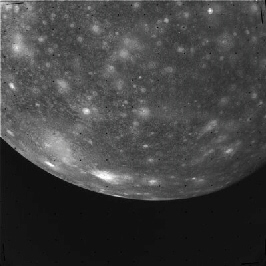 This image of
Calisto, one of Jupiter's Moons, looks very active, but the moon
itself is rather passive. I will write the quality off to the
image, rather than the moon.
This image of
Calisto, one of Jupiter's Moons, looks very active, but the moon
itself is rather passive. I will write the quality off to the
image, rather than the moon.
Calisto has many sisters, some of whom have not been photographed.
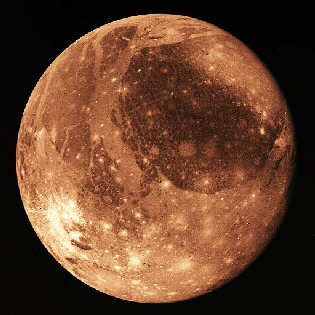
Gaynemede has gotten a bit of press over the years. This wonderfully detailed image is also filtered, for the natural color of Gaynemede is not copper.
Notice the surface patterns, and the southern ice cap.
 An incredible
texture mapped image of Io and Jupiter together, shows her
surface patterns in complememt with Jupiter's clouds and storms.
An incredible
texture mapped image of Io and Jupiter together, shows her
surface patterns in complememt with Jupiter's clouds and storms.
Too bad this shot of Jupiter is missing her signature giant storm, or the red "eye" we see so often. Then again, that red spot is bigger than most planets in our solar system.
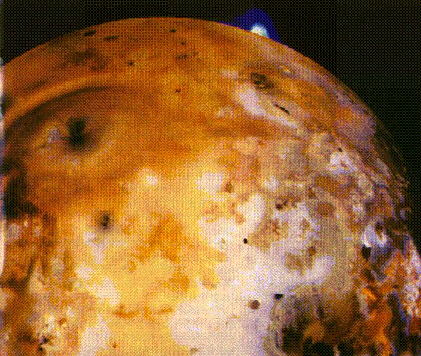 Io, like the Earth is actively volcanic. This is
a rare quality in our solar system, but indicates some of the
similarities between our home, and other parts of our galaxy.
Io, like the Earth is actively volcanic. This is
a rare quality in our solar system, but indicates some of the
similarities between our home, and other parts of our galaxy.
We may also be seeing the early stages of a habitable planet forming.
Only time will tell.
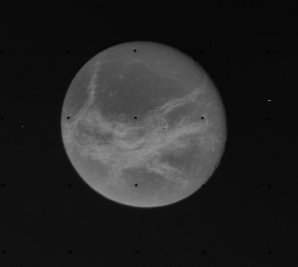
And from Saturn, we meet Dione.
Her surface patterns are rather distinct as well. Don't mind the composite dots. They were used to put the image together.
Not by me, for no assembly was required beyond gathering these pics together. I imagine the scientists who do put all the components together must like puzzles.
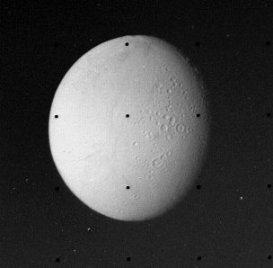
And this is Enceladus. Her surface is clearly marked by time, and the passing of minor celestial bodies. Nothing seems to have left any large footprints behind, not like Phobos.
Enceladus is also a Saturnian moon.
Due to the gaseous natures of both Jupiter and Saturn, these moons are the most likely places we will colonize, once we reach out this far.
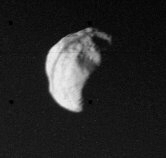 Epimeth is more a chunk of rock, rather than a
moon as we know it.
Epimeth is more a chunk of rock, rather than a
moon as we know it.
It is small, and misshappen as if it was an asteroid once in it's life. It appears that Saturn's gravity well caught it. It definately doesn't look like it was spun in orbit.
 Back to Jupiter, with Europa here.
Back to Jupiter, with Europa here.
In the movie 2010, we were warned to leave this moon alone. Granted, it was only a motion picture.
The surface seems to have channels cut into it, as can be seen in this composite.
There may even be a thin atmosphere, as well. Direct exploration is in order.
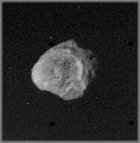 Hyperion, from
orbit of Saturn, appears to be another hunk of space debris that
was captured by Saturn's gravity. Eons ago, it was just happily
floating in space, when suddenly it gets locked into orbit around
a ringed gas giant...
Hyperion, from
orbit of Saturn, appears to be another hunk of space debris that
was captured by Saturn's gravity. Eons ago, it was just happily
floating in space, when suddenly it gets locked into orbit around
a ringed gas giant...
And we thought we have bad days....
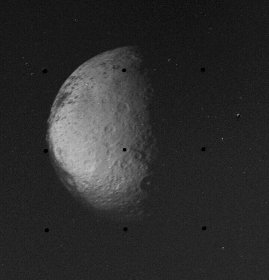
Here we have Iapetus, again from Saturn. This surface is varied, and marked well with craters. It lacks the straight lines typical of channeling, this appears never to have seen water in any form.
But We haven't seen the other side yet...
Only kidding. Iapetus is very much like our own moon.
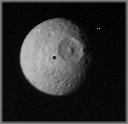 Mimas, circling around
Saturn, is small. Here is a great view of a nearly perfect impact
site. Note the raised center.
Mimas, circling around
Saturn, is small. Here is a great view of a nearly perfect impact
site. Note the raised center.
Kinda reminds one of the Death Star. He's headed toward that small moon. That's no moon...
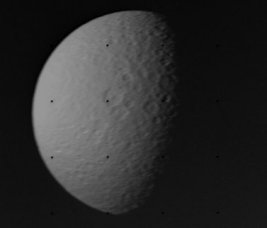 Rhea is another Saturnian satellite. She seems
rather smooth, and without any atmosphere at all. Looks to be a
perfect sphere of rock and dust. Even the craters appear worn
with time. It has been a long time since anything has struck the
surface of this moon.
Rhea is another Saturnian satellite. She seems
rather smooth, and without any atmosphere at all. Looks to be a
perfect sphere of rock and dust. Even the craters appear worn
with time. It has been a long time since anything has struck the
surface of this moon.
Nice detail overall. A fine example of a moon. Well, maybe a tad small...and craters do add so much character...
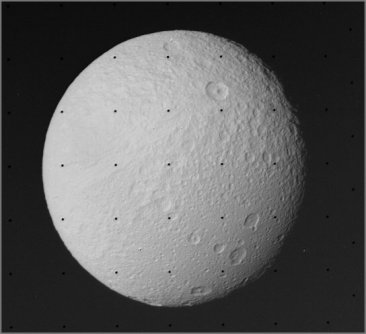 Tethys is another fine specimen of moonkind.
Again, no atmosphere on this lady, you can see she bears her
scars proudly.
Tethys is another fine specimen of moonkind.
Again, no atmosphere on this lady, you can see she bears her
scars proudly.
It is hard to imagine that much activity, that much material hitting this little planetoid, and now nothing.
The birth of our galazy was a long, violent process.
I can't wait for the video...It'll be better than the view from the Restaurant at the End of the Universe.
 At the end of our gallery, is Titan. Note the
cloud rings in the atmosphere. Yup, that's a gas soup blanketed
on that hunk of rock.
At the end of our gallery, is Titan. Note the
cloud rings in the atmosphere. Yup, that's a gas soup blanketed
on that hunk of rock.
That means something could
The chance for life increases greatly with an atmosphere. Plus, Titan's good sized...
Back to BGHOTW SSA